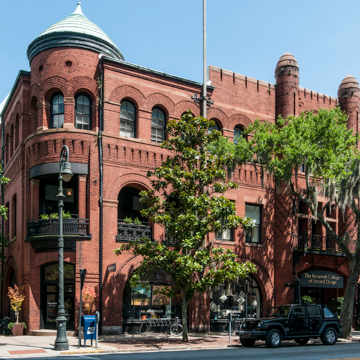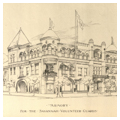You are here
Poetter Hall, SCAD
When Jasper Ward was laid out, the city granted two lots to the Female Orphan Asylum, which built a highly publicized structure on this site in 1838 and then added another lot to accommodate a garden in 1846. When the orphanage was reorganized and relocated to the now-demolished Wetter House on West Broad Street in 1888, the Savannah Volunteer Guards bought the property and replaced the building with this castlelike armory. Preston's design is a romantic mélange of red brick towers and rounded arches, suggestive of a fortress but also reflective of his exuberant Hotel Desoto, which formerly stood across the square. The 24-pounder cannon flanking the entrance, which were discovered buried under the previous Volunteer Guard Armory during its demolition, are the oldest extant cannon forged by the U.S. government. At the rear stands the original drill hall; along the north side there was once a rifle range and then an indoor swimming pool. In 1978 the armory became the first of many derelict buildings in Savannah to be renovated and adaptively reused by SCAD, for which it remains the flagship building.
Writing Credits
If SAH Archipedia has been useful to you, please consider supporting it.
SAH Archipedia tells the story of the United States through its buildings, landscapes, and cities. This freely available resource empowers the public with authoritative knowledge that deepens their understanding and appreciation of the built environment. But the Society of Architectural Historians, which created SAH Archipedia with University of Virginia Press, needs your support to maintain the high-caliber research, writing, photography, cartography, editing, design, and programming that make SAH Archipedia a trusted online resource available to all who value the history of place, heritage tourism, and learning.

















